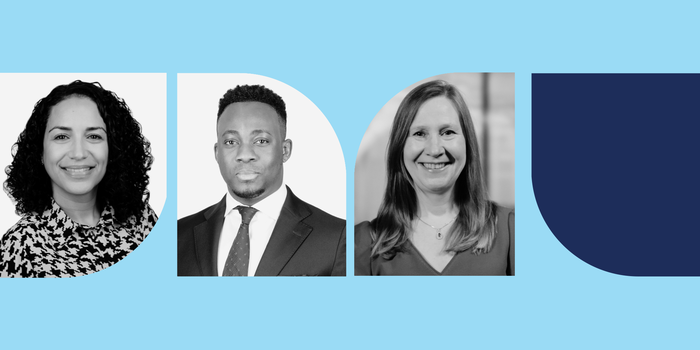
The benefits of traditional mentorship have long been understood: Less experienced professionals have much to gain from someone more senior who can provide guidance, encouragement, and feedback as it relates to their life and career.
But what happens when the idea of mentorship is flipped on its head, and the senior-level person plays the role of mentee? That’s exactly what BlackRock aimed to find out with its new reverse mentorship program, one of the company’s many initiatives aimed at helping its employees learn and grow.
The roots of the program can be traced back to 2021, when the firm’s offices in the EMEA (Europe, Middle East, and Africa) region launched a campaign called “Count Me In,” to encourage employees to share information around ethnicity, gender identity, and sexual orientation. The goal was to shed greater light on the different backgrounds and identities of the firm’s many employees in an effort to better meet their unique needs and help them thrive in their careers.
BlackRock created a reverse mentorship program in which underrepresented employees mentored senior leaders to provide an opportunity for participants to share and learn. Expert Patrice Gordon, author of Reverse Mentoring: Removing Barriers and Building Belonging in the Workplace, helped develop the voluntary program, which launched with a six-month pilot in March 2023.
“For me, it was about this education around what it’s really like to be an underrepresented professional at BlackRock,” says Melanie Seymour, Global Head of Client Experience and a mentee, as well as one of the program’s sponsors. “I wanted to understand through that lived experience of somebody else how they find the firm compared to me. And with that knowledge, how I can support broader programs and initiatives that address these differences.”
Making the Right Matches
When Seun Fayoyin, a London-based director in BlackRock’s global consultant relations group, was asked to be a mentor, he was hesitant at first. For starters, he had never really talked about what it was like to be part of an underrepresented population at the company.
“I’ve always focused on my work and tried to be as exemplary as possible. Oftentimes people, particularly in underrepresented groups, don’t want to draw attention to themselves because they don’t want to draw attention to the things that make them feel different,” he says. “The reverse mentorship program put me in a position to be able to open up about some of the experiences that I’ve had.”
Fayoyin found he was able to do just that with Seymour, who was his mentee. “It was obvious from the get-go that she was invested in learning about me and my experiences,” he says. “She shared a lot about herself as well, which helped develop a great deal of trust.”
Seymour’s experience was equally positive and impactful. “I think it worked well because we both went into this with open minds and were willing to be honest with each other,” she says. “Seun didn’t feel like he had to hold back or that there were things he shouldn't say.”
Fayoyin and Seymour were one of 20 total reverse mentorship pairs across the globe, all of which were matched very intentionally. For example, mentors and mentees worked in different functions and on different teams to help them feel more comfortable talking about sensitive topics. It also helped them expand their networks within BlackRock.
Before each meeting, they were provided with conversation guides containing sample questions and discussion topics, including those around external current events and how they affected people from different communities within the firm.
“We were really clear that the mentee would drive the relationship,” says Lauren Baer, a director and EMEA Head of Diversity, Equity, and Inclusion who is based in London. “They needed to set up the meetings, lead the conversation, and really think about how they're reflecting and listening.”
Positive Results on Both Sides
The new program wasn’t Seymour’s first experience with reverse mentorship. She’d previously sat down with more junior tech colleagues at the firm to make sure she understood AI and machine learning, and to discuss their implications within the industry.
But with Fayoyin, the relationship grew to be more meaningful—and reciprocal. “I definitely got out of it what I wanted, which was to listen and learn,” Seymour says. “But we also gained more from each other, and it became a mutual relationship.”
Fayoyin now thinks of Seymour as a mentor as well, and appreciates that he has someone at a senior level who can help him navigate his career at the firm. But, perhaps more importantly, he and other mentors came away feeling like their voices were valued. The mentees, meanwhile, believed they became better listeners and leaders.
“They learned how to really sit with what they’re hearing,” Baer says. “Instead of trying to quickly fix a situation, they are thinking about their leadership style and how they’re showing up for their team.”
In response to the successful pilot program, Baer is developing a global toolkit, which will include all of the materials needed for the program to be implemented for various functions and demographics. Seymour believes it is imperative to continue the reverse mentoring program across the firm.
“Reverse mentorship is an underutilized resource in organizations,” she says. “Understanding the lived experiences of others is becoming more and more important, especially when you think of a multigenerational workforce. We need a way to have understanding across different levels of diversity.”
And any hesitancy Fayoyin felt before the program began has disappeared.
“You don’t often find companies of this scale having a program that’s dedicated to bridging the gap between different groups and levels of people,” he says. “I was very impressed by it and 100% think we should roll it out more widely. The more people who experience it and have an opportunity to use their voice, the better.”